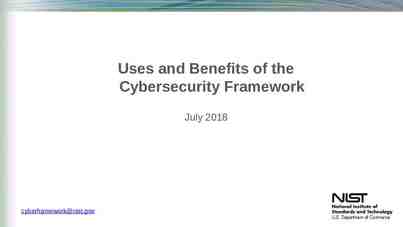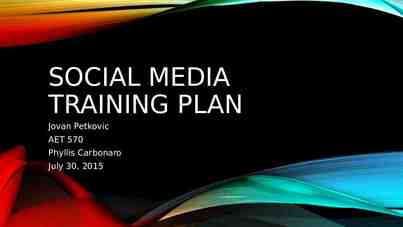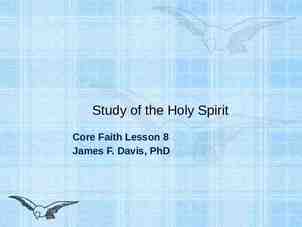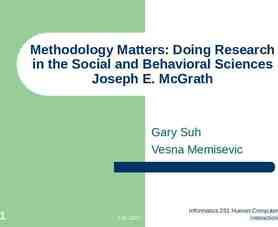Maximizing Your FAR Overhead Rate Presented by: Scott Sutton,
52 Slides1.05 MB

Maximizing Your FAR Overhead Rate Presented by: Scott Sutton, CPA, CDA, MSA and Ken Hedlund, CPA, CGMA 3925 River Crossing Pkwy, Suite 300 Indianapolis, IN 46240 317.472.2200 / 800.469.7206

Lesson Topics Categories of Cost Pools Cost Principles and Procedures Specific Costs Deferred Compensation

Learning Outcomes After completing this lesson, you should be able to: Explain and distinguish between the FAR cost principles of allocability, allowability, and reasonableness. Define directly associated costs and explain its applicability to allowability. Evaluate and discuss examples of expressly unallowable cost categories and those costs requiring additional analysis to determine allowability.

Direct and Indirect Costs Direct Costs: All costs incurred for a project. Includes costs which are not billable to the client. "Project chargeable" vs. "billable" costs. Indirect Costs: All costs not specificall y incured for a project. Includes allowable costs and unallowabl e costs

Cost Principles and Procedures Allowable Reasonable Allocable – Burden of Proof – Documentation Who, What, Where, When, Why (5 W’s)

Allowable Allowable Costs – Must be reasonable in amount. – Allocable to Government contracts – Compliant with Generally Accepted Accounting Principles and standards promulgated by the Cost Accounting Standards Board (when applicable) – Compliant with the terms of the contract (Billable and Unbillable costs) – Not prohibited by any of the FAR Subpart 31.2 cost principles.

Directly Associated Costs Cost that is incurred as a result of incurring another related costs. – Example – Vehicle expenses related to travel to a trade show. Need to consider directly associated costs when considering direct versus indirect costs.

Reasonable FAR Part 31.201-3(a) – A cost is reasonable if, in its nature and amount, it does not exceed that which would be incurred by a prudent person in the conduct of competitive business. – Referred to as the “prudent person test” – No presumption of reasonableness shall be attached to the incurrence of costs by a contractor if an initial review of the facts results in a challenge of a specific cost the burden of proof shall be upon the contractor to establish such cost is reasonable.

Allocability Allocating costs to direct or indirect, and if direct, to the appropriate project. Key factor is “why was the cost incurred?” Allocation based on the benefits received. Be sure to document why cost was allocated in a certain manner.

Allocability Costs that are allocable to a government contract will fall into one of three categories: – Costs incurred specifically for the contract – Costs that benefit both the contract and other work, and can be allocated in reasonable proportion based on the benefits received – Costs incurred for the overall operation of the business

Documentation Requirements Support for business purpose 5 W’s – Who, What, When, Where, Why Expense reports, company credit cards, and vendor invoices Adequate documentation is necessary to support FAR Allowability

Significance of Overhead Rate During auditor testing of the indirect costs, sampling is used to verify the allowability and reasonableness. Sampling provides a bases for the known error (allowability and reasonableness) that is extrapolated to the entire population. Testing for the 5 W’s – Who, What, When, Where, Why

Significance of Overhead Rates See Examples of Impact of Extrapolated Error on Overhead Rate

Specific Indirect Costs

Unallowable Costs Entertainment Alcohol Contribution s and donations Interest Public relations Advertising Bad debts Lobbying Organization and and political reorganization activities costs

Directly Associated Costs When a cost is determined to be unallowable, the directly associated costs are also unallowable. FAR 31.201-6 states: “A directly associated cost is any cost that is generated solely as a result of incurring another cost, and that would not have been incurred had the other cost not been incurred. When an unallowable cost is incurred, its directly associated costs are also unallowable.” Pay Stub

Introduction to Costs Requiring Additional Analysis to Determine Allowability Travel, airfare, per diem Vehicle costs Selling costs Bid and proposal Conferences and seminars Miscellaneous (other)

Travel, Airfare, and Per Diem Allowability of travel costs Lodging, meals, and incidentals Transportation and airfare Documentation Especially the WHY To be allowable, airfare must be the lowest priced available during normal business hours. FAR 31.205-46, 31.205-46(a)(7), 31.205-46(b), 31.205-46(c);

Per Diem Rates for Lodging and Meals STATE DESTINATION IN Indianapolis/Carmel IN South Bend MI Detroit MI East Lansing / Lansing OH Akron OH Cleveland OH Columbus Standard CONUS rate for counties not listed in CONSUS database. Cities not listed may be located in a listed county. Mexico Puerto Vallarta COUNTY / LOCATION DEFINED Marion/Hamilton St. Joseph Wayne Ingham / Eaton Summit Cuyahoga Franklin FY2016 Lodging FY2016 M&IE Rate 107 92 115 96 103 125 109 89 181 64 59 54 59 54 69 59 51 99

Meal & Incidental Expenses Per Diem Breakdown M&IE TOTAL 51 54 59 64 69 74 CONTINENTIAL BREAKFAST/BREAKFAST 11 12 13 15 16 17 LUNCH 12 13 15 16 17 18 DINNER 23 24 26 28 31 34 5 5 5 5 5 5 INCIDENTALS

Vehicle Costs Unallowable: Personal use of company-owned or –leased vehicle Directly associated costs Documentation critical Mileage and WHY ALLOWABLE: Cost of business use, such as costs of lease, operation, maintenance, depreciation, insurance, etc. FAR 31.205-46(d); 31.205-6(m)(2); AASHTO Audit Guide

Mileage Logs Mileage on company owned/leased vehicles can be allowable under certain criteria. Mileage logs must be kept on every vehicle the company owns or leases. Mileage logs must have the 5 W’s (who, what, where, when and why) documented for proper determination of allowability.

Mileage Logs (cont.) Mileage is unallowable for the following: – Direct project work (Direct vs. Indirect) – Unallowable selling related activity – Personal use/commuting use – Political use (political fundraiser events) – Entertainment use (sporting events, golfing events, etc.) – Certain charity events

Mileage Logs (cont.) Example of bad mileage logs Mileage Log and Reimbursement Form Employee Name Employee ID Vehicle Description Rik S. 051 Blue Truck Authorized By Date 1/ 30/ 2014 2/ 3/2014 Project Number 101010-AA 101010-AA Project Name 2/ 3/2014 Overhead Overhead Starting Location Office - Fort Wayne Office - Fort Wayne Project Site - 101010AA 2/ 7/2014 Overhead Overhead Office - Fort Wayne 2/ 13/ 2014 2/ 15/ 2014 2/ 16/ 2014 Overhead Overhead Overhead Overhead Overhead Overhead 2/ 20/ 2014 2/ 22/ 2014 2/ 24/ 2014 2/ 28/ 2014 0566939-EA Overhead Overhead Overhead Overhead Overhead Overhead Office - Fort Wayne Office - Fort Wayne Home Project Site - 101010AA Office - Fort Wayne Office - Fort Wayne Home Rate Per Mile 0.755 For Period From 1/ 30/ 14 to 2/ 28/ 14 Total Mileage 770 Total Reimbursement 581.35 Destination Project Site Project Site Office - Fort Wayne County Commissioner Office County Commissioner Office Office - Indianapolis Marriot - Fort Wayne Description/ Notes Odometer Odometer Start End 45879 46001 46120 46242 Mileage Reimbursement 122 92.11 122 92.11 meeting 46246 46368 122 92.11 meeting 46407 46450 43 32.47 meeting lunch ACEC 46530 46601 46760 46573 46751 46781 43 150 21 32.47 113.25 15.86 46801 46920 47710 47790 46834 33 23 70 21 0 0 0 0 24.92 17.37 52.85 15.86 0.00 0.00 0.00 0.00 770 581.35 Project Site - 0566939-EA Tri-Field ACEC The Steakhouse lunch Marriot - Fort Wayne ACEC 47780 Totals

Mileage Logs (cont.) Example of good mileage logs Mileage Log and Reimbursement Form Employee Name Employee ID Vehicle Description Authorized By J uno J . 050 2012 Buick LaCrosse Gary G. Date 1/ 30/2014 2/3/ 2014 Project Number 101010-AA 101010-AA Project Name Contract A Contract A 2/3/ 2014 Overhead Overhead 2/7/ 2014 Selling Selling 2/ 13/2014 2/ 15/2014 2/ 16/2014 Bid Proposal Overhead Marketing Bid Proposal Overhead Marketing 2/ 20/2014 2/ 22/2014 0566939-EA Marketing Contract E Marketing 2/ 24/2014 2/ 28/2014 Selling Seminar Selling Seminar Starting Location Office - Fort Wayne Office - Fort Wayne Project Site - 101010AA Office - Fort Wayne Office - Fort Wayne Office - Fort Wayne Home Project Site - 101010AA Office - Fort Wayne Office - Fort Wayne Home Rate Per Mile 0.560 For Period From 1/ 30/ 14 to 2/ 28/ 14 Total Mileage 770 Total Reimbursement 431.20 Destination Project Site Project Site Office - Fort Wayne County Commissioner Office County Commissioner Office Office - Indianapolis Marriot - Fort Wayne Description/ Notes Perform Staking Site Survey Weekly Office Meeting for department Meet with Commissioner re: I65 potential project Propose bid on I-65 project New hire lunch Trade show expo Project Site - 0566939-EA Project management Tri- Field Country Club Golf Outing - ACEC Lunch w/Lake County re: upcoming Spring county The Steakhouse projects Marriot - Fort Wayne ACEC training Odometer Odometer Start End 45879 46001 46120 46242 Mileage Reimbursement 122 68.32 122 68.32 46246 46368 122 68.32 46407 46450 43 24.08 46530 46601 46760 46573 46751 46781 43 150 21 24.08 84.00 11.76 46801 46920 46834 46943 33 23 18.48 12.88 47710 47790 47780 47811 70 21 0 0 0 0 39.20 11.76 0.00 0.00 0.00 0.00 770 431.20 Totals

Selling Costs Criticality of proper categorization and segregation Generally Allowable: Market planning Direct selling Bid and proposal costs FAR 31.205-38 defines these selling categories: Advertising Corporate image enhancement Bid and proposal Market planning Direct selling FAR 31.205-12 ; FAR 31.205-38; AASHTO Audit Guide Section

Selling Expenses Generic term encompassing all efforts to market a consultant’s services. Includes – advertising, public relations, bid and proposal, market planning and direct selling.

Selling Expenses (cont.) Advertising is the use of media (conventions, exhibits, free goods, magazines, newspapers, outdoor advertising, radio, television, etc.) to promote sale of products or services. (FAR 31.201-1) – Only allowable advertising costs are those specifically required by contract, costs related to employee recruitment or costs to promote sales of services normally sold to the US government.

Selling Expenses (cont.) Public relations (PR) is maintaining, protecting, and enhancing the image of a concern or its products or maintaining or promoting reciprocal understanding and favorable relations with the public at large, or any segment of the public. – Allowable PR costs are those specifically required by contract, costs of responding to inquiries on company policies and activities, costs of participation in community service activities, and costs of plant tours and open houses (but not if designed to call favorable attention to the consultant and its activities.)

Selling Expenses (cont.) Public relations (cont.) – Unallowable activities include – activities whose primary purpose is to promote sale of products/services, messages calling favorable attention to the consultant, costs of trade shows which do not contain significant effort to promote export sales of products normally sold to the US government, costs of sponsoring meetings, conventions and other events when principal purpose is other than dissemination of technical information.

Selling Expenses (cont.) Public relations (cont.) – Other unallowable activities include – Costs of corporate celebrations Costs of promotional material designed to call attention to the consultant Costs of souvenirs, imprinted clothing, buttons and other mementos provided to customers and public Costs of memberships in civic and community organizations.

Selling Expenses (cont.) Bid and proposal costs are costs incurred in preparing, submitting and supporting bids and proposals (whether or not solicited) on potential contracts. – Allowable to the extent that they are reasonable. – Activities include – responding to RFP’s, developing technical and cost proposals, and project scoping prior to contract execution

Selling Expenses (cont.) Market Planning – involves market research and analysis and generalized management planning concerned with development of consultant’s business. – Allowable to extent they are reasonable.

Selling Expenses (cont.) Direct selling efforts are acts or actions to induce particular customers to purchase particular products or services of the consultant. – Characterized by person-to-person contact – Activities include: Familiarizing a potential customer with consultant’s services, capabilities, etc. Negotiations, demonstrations, liaison between customer and contractor personnel. Meetings with current or prospective clients to discuss potential future work. – Allowable if amounts are reasonable.

Selling Expenses (cont.) Allowable and unallowable selling expenses must be segregated per FAR. Time input should provide ability to segregate unallowable selling efforts (time incurred) from allowable selling efforts. Time input, expense report, and credit card receipts should include description of the 5 W’s – who, what, where, when, and why.

Selling Expenses (cont.) Summary – Unallowable items – includes time worked on and expenses related to golf outings, concerts, sporting events, working a trade show booth at a conference, any type of promotional handouts, advertising and public relations. – Allowable items – includes time worked on and expenses related to bid and proposal work, market planning work, and direct selling activities(face-to-face meetings).

Conferences and Seminars Allowable: Dissemination of trade, business, technical, or professional information Stimulation of production or improved productivity Documentation FAR 31.205-43 Criteria for advertising and public relations still apply.

Miscellaneous Pre-contract costs (FAR 31.205-32) Relocation costs (FAR 31.20535) Training and education costs (FAR 31.205-44) AASHTO Audit Guide Section 8.25

Remember: Adequate Documentation is Important Cost allowability dependent on adequate documentation 5 W’s A/E consultant bears burden of proof of cost allowability FAR 31.205 Invoice Mileage Travel Log

Lesson Summary What questions do you have about: How the Company overhead rate is calculated and its impact to the Company. Defining directly associated cost and explaining its applicability to allowability? Evaluating examples of expressly unallowable cost categories and those requiring additional analysis to determine allowability?

Examples

Deferred Compensation and your Overhead Rate

Discussion Points Attract, retain and reward top, key talent Complete flexibility in design (customize to meet goals / needs) In addition to compensation and cash bonuses (not a take away) First and foremast reward for key employees for their contributions Recognition of substantial contributions to the operations and financial success of the organization Provide additional financial security as an inducement to remain employed with the corporation

Characteristics of and Requirements for a Deferred Compensation Plan Non-qualified plan Written agreement between the Company and executive/key employees Can limit participation to executives/highly compensated/other key employees Employee agreed to have part of their compensation deferred by the company and awarded at some time in the future as a bonus plan with earning, deferral and vesting considerations Must be substantial risk of forfeiture or strong possibility the employee might leave for plan to be tax deferred

Discussion Points Build in a vesting schedule (example 3 or 5 year rolling vesting) Some window of time identified to realize vested portion of benefit (i.e. year 4 or 6) But if separation, potential to leave an amount on the table Individuals continue to be a participant until account is distributed or forfeited in accordance with the plan Deferred value meaningful value to be effective (hard to define, based on individual circumstances)

Discussion Points Fully vest on certain triggering events i.e. Death X years with the company and attend defined retirement age Creating Deferred Compensation Pools: Identify corporate performance needed Identify personal CFI and KPIs for individual performance Annual Statement Provided Annually (Pools Created, Interest/Growth, Vesting, Payout and Forfeiture)

Characteristics of and Requirements for a Deferred Compensation Plan Pre-determined criteria for participation (optional) Predominately a performance based plan (handling of annual change between participants can vary to design) Can have various levels of participation (A, B units, etc.) Complete flexibility in design Funding Formula (stock value, annual profitability) Vesting Terms Payout Terms

Characteristics of and Requirements for a Deferred Compensation Plan Obligation accrued on balance sheet, impact financials and ratios Impacts financials, cash if funded, accrued liability, net profit, and equity Impacts ratios, working capital, debt to equity, profitability and others Obligation will have short term and long term components Can pro-rate and net present value obligation as earned Tax Considerations Not deductible to Company or included in employee income until earned and paid for federal and state income tax Special FICA / Medicare treatment when earned and not subject to substantial risk of forfeiture

Characteristics of and Requirements for a Deferred Compensation Plan Funding of obligation (optional but recommended) Consideration of use of Rabbi Trust Allows participant “limited” input over investment of funds (careful, need to avoid constructive receipt) Level of protection from creditor claims in ordinary course of business (not company bankruptcy) Subject to 409A regulations, tax code with detailed requirements, deferral elections, distributions, etc. Thorough preparation of documents to protect Company

Characteristics of and Requirements for a Deferred Compensation Plan Attorney will draft documents Top Hat filings Recorded in board minutes and parameters defined Often clause that employee death or permanent disability will provide for immediate vesting and payment to employee or estate Often life insurance used for funding in case of death

Phantom Stock Plan Design within the Deferred Compensation Structure Form of deferred compensation plan; most points from above apply under deferred compensation Primary difference is, as name implies, that it is typically tied to a pre-determined member interest or stock formula value Key employees are awarded units of Phantom Interest or Stock Determined value in issued year is base price of Phantom Interest or Stock (base zero compensation value) Increase in interest or stock valuation from base year equates to annual compensation amounts Phantom interest or stock value can increase/decrease based on formula

Other Strategies Research & Development Credit Section 179D Deduction Domestic Production Activities Deduction (DPAD) Succession Planning Management Company Performance Management






